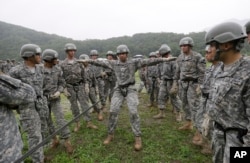President Donald Trump’s carefully worded and measured condemnation of North Korea’s missile test on Sunday leaves unclear what new policies he may pursue to halt the Kim Jong Un government’s advancing nuclear program.
Standing alongside Japanese Prime Minister Shinzo Abe, who called North Korea’s missile launch "absolutely intolerable," Trump said, “The United States of America is behind Japan, our great ally, 100 percent."
During their weekend summit, in which the two leaders played golf at Trump’s Mar-a-Lago estate in Florida, Abe sought and for the most part received reassurances from Trump that the U.S. will maintain its longstanding military alliance with Japan.
With its missile test, analysts said, Pyongyang wanted to send the new American president a message of defiance.
“I think the message is that, ‘we will not be coerced; or any use of force against us, any attack against us, will have consequences. We have ways to deliver reprisals and punishment against the U.S. and its allies in the region,’” said Daniel Pinkston, a lecturer in international relations with Troy University in Seoul.
Since taking office President Trump and his Secretary of Defense Jim Mattis have emphasized America’s continued commitment to support its allies in Asia against the growing North Korean nuclear threat. Mattis' first trip abroad was to Asia.
Diplomatic oversight
However Trump’s disruptive rhetoric about China and alliances in the region has raised doubts that his administration can effectively work with other countries to exert increased pressure on North Korea.
For example, missing from Trump’s strong show of support for Japan was any mention of South Korea.
“Not mentioning South Korea as part of the equation is contrary to the Obama administration’s rebalancing strategy to the Asia Pacific region, which was rooted in the premise that the most effective way of achieving the goal depends upon consolidating the trilateral security partnership among the U.S., Japan and South Korea,” said Bong Young-shik with the Yonsei University Institute for North Korean Studies in Seoul.
Even if this was just a diplomatic oversight by a new administration, Bong said, the omission raises concerns in Seoul that Washington is prioritizing Tokyo, at a time when tensions are rising again between Japan and South Korea over atrocities dating back to World War II.
No military option
Trump’s response was reassuring to many in that he did respond impulsively on Twitter as he seemed to do in January when he tweeted “It won’t happen!” to refute Kim Jong Un’s New Year’s Day message that said his country is prepared to conduct an intercontinental ballistic missile test.
While some conservatives in Washington have suggested the Trump administration consider launching a preemptive military strike to prevent an ICBM test, this recent missile launch showed how difficult that would be. The missile was reportedly fired from a mobile launch vehicle that could be moved and hidden from monitoring satellites.
Also any U.S. military strike against North Korea would likely provoke a deadly response and possibly trigger a wider conflict and even a nuclear war.
“Let's face facts, North Korea has nuclear weapons. So you are not going to try to do any Iraq invasion style regime change,” said Harry Kazianis, the Director of Defense Studies at the Center for the National Interest in Washington.
Kazianis says the U.S. options under Trump are therefore somewhat the same as they were under President Barack Obama: to increase conventional military deterrence to defend and counter the North’s increasing nuclear capabilities, and to increase pressure on the Kim Jong Un regime through sanctions and diplomatic isolations.
Washington and Seoul have committed to soon deploying the THAAD missile defense shield, a decision that has raised objections from China that the American advanced system can be used to monitor other countries in the region. THAAD is also drawing increasing opposition in South Korea where critics say it is not worth the price of economic retaliation from Beijing.
China and sanctions
Beijing’s support for international sanctions continues to be crucial as 90 percent of North Korean trade flows either to or through China. But Beijing has been reluctant to strictly enforce measures that might create widespread instability on its border or lead to the collapse of the Kim government that it sees as a buffer against increasing U.S. and South Korean power and influence in the region.
During the campaign Trump said he would demand Beijing exercise control over its client state. To increase economic pain on Pyongyang, the U.S. could punish more Chinese companies that do business with North Korea by targeting them with unilateral sanctions and by seizing their financial assets. But such a move would likely trigger economic retaliation from Beijing.
Trump has already angered the leadership in Beijing by questioning the One China policy, which says that the U.S. will not challenge China’s claim to Taiwan. In a phone call with Chinese President Xi Jinping last week the president walked back his earlier comments and reaffirmed the One China policy.
Youmi Kim in Seoul contributed to this report.








